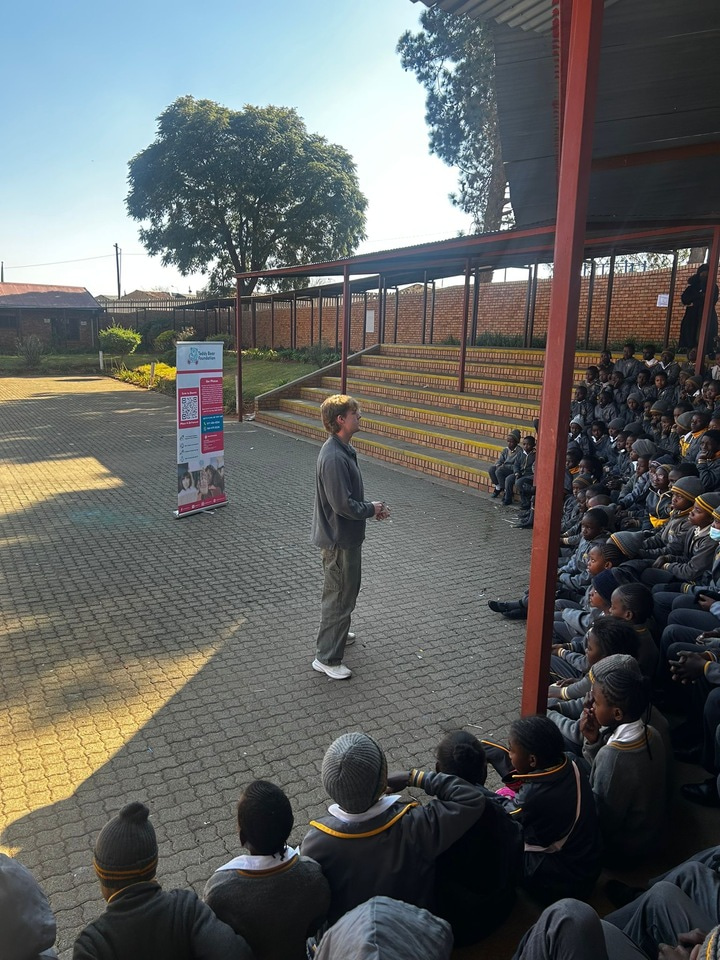LiA Log - Week 2 - A Week of Learning

Now situated in the Reef Hotel in Marshalltown, just south of the Johannesburg CBD, an area known for its danger, I entered this week with a sense of excitement. I felt that I had learned a lot from my first week and knew that this one would be packed with even more opportunities for growth. In week one, I was merely a passive observer, but this week, I was set to engage much more frequently and meaningfully in the sessions, as was planned.
I really felt this week that I was starting to assimilate into the work culture. I knew everyone’s name, everyone greeted me, and I felt more connected to the team. This sense of belonging was incredibly rewarding. It was no longer just about the heavy emotions of witnessing young people suffer, but also about experiencing some joy at work. Feeling seen, known, and liked meant that work wasn’t all stress, but a mix of both challenges and moments of fun. This positivity helped reframe my experience – moving from being an observer and what felt like a ‘useless intern’ to someone who had an active role to play. I was truly excited to contribute and make a difference.
In that vein, I led two significant workshops this week. The first was on youth pregnancy with 100 schoolboys aged 12-16 with intellectual disabilities in Gaudwes, and the second was on bullying and its relationship to gender-based violence (GBVF) in Soweto, with around 70 schoolchildren aged 8-12. Both sessions posed unique challenges.
The Bullying and GBVF Talk
Let’s start with the second session in Soweto. I was put on the spot for this one. The day before, I was told I’d be leading the session, with instructions to familiarise myself with The Teddy Bear Foundation’s guidelines on the issue. That was difficult enough, but things were made harder by the fact that the lead of the session had only recently joined the organisation and didn’t have many notes for me to work from. So, I spent a long night researching and preparing, followed by a few hours the next morning going over my material.
On the day, I walked into a school with no spare chalkboards, let alone the means to display a PowerPoint. So, keeping the children engaged on such a sensitive topic (one they were likely not particularly interested in) felt like a big challenge. However, with guidance from Zanele, I learned to use some great engagement tricks: intonations, focus-inducing rhymes (think “1, 2, 3, eyes on me”), and quizzes with sweets as rewards. These strategies helped maintain attention, and the session went much more smoothly than I anticipated.
This experience raised an important issue about measuring success. The Teddy Bear Foundation’s donors want statistics to show where their money is going, but they measure this success in terms of children reached. This is inherently flawed. If I speak to 100 children for just 10 minutes about bullying, the likelihood of something being remembered or internalised is low, even with the engagement techniques. However, if I spent 30-40 minutes with just 6-7 children and engaged with them deeply, the impact could be far more profound.
This notion of shallow metrics – specifically “children reached” – plagued me throughout the week. It’s something I came to reflect on as the weeks went by. The real impact of talks like this is more often felt implicitly. Anti-bullying and anti-GBVF initiatives must be fully integrated into the culture of a school, through posters on the walls, charity-led presentations, and restorative punishments for rule-breakers. Only then does the message truly get through. It’s hard to measure the direct impact of a single talk, but over time, with full integration, schools can see significant positive changes.
The Youth Pregnancy Session
The second session in Gaudwes posed different challenges. I was given the material well ahead of time and had plenty of time to prepare. I knew I was working with young men, which was helpful, but two unforeseen challenges arose that will be useful for me to navigate in the future.
The first challenge was the content itself. The material provided by The Teddy Bear Foundation positioned boys as responsible for protecting young girls and encouraged them to show empathy for how girls might feel. In South Africa, this approach works well because men are culturally expected to be “strong.” The idea of co-opting this idea of strength for the protection of women might be controversial, but it likely leads to fewer acts of aggression that cause youth pregnancies. While it may implicitly feed into some misogynistic attitudes, it’s still an approach that works in this context.
However, the boys didn’t seem at all interested in the material. The session felt flat until I opened the floor for questions. Suddenly, the boys were asking questions about consent, how to avoid being pressured into having sex, how to know if a girl wants to have sex with you, and how to ask a girl out. What these boys needed was a presentation that focused on their own concerns. By addressing their worries and teaching them how to engage respectfully with young girls, I would be guiding them toward behaviours that could reduce youth pregnancy.
A second challenge emerged when I opened the floor to more questions. One boy asked, “What should you do if you accidentally get a girl pregnant and you don’t want to keep the baby, but she does?” To my shock, another boy answered loudly, “Kill the bitch,” which elicited snickers from the rest of the group. I was immediately out of my depth. How could I, a 22-year-old foreigner, respond to such a statement? Luckily, Sonja, the manager of the Youth Pregnancy section, stepped in and handled the situation with a stern but well-chosen response. It highlighted the culture in areas like Gaudwes, where such casual misogyny is acceptable. It was a sobering moment, but it gave me much to think about in terms of how I can handle similar situations in the future.
The “At the Crossroads” Curriculum Launch
In the midst of a very busy week, I also had the chance to attend the “At the Crossroads” curriculum launch. Compared to the previous sessions, this event was a breeze. A few points stood out to me:
-
The presence of brands like Nestlé as sponsors raised some eyebrows, especially given that such companies are often seen as controversial in humanitarian and educational contexts. This speaks to the government’s apparent desperation for capital to get the curriculum off the ground.
-
The curriculum, delayed for several years, is focused on life skills to address South Africa’s social problems. I think this is a positive initiative, but the delays show just how challenging it can be to implement large-scale educational reforms.
-
The event was a great networking opportunity, allowing me to meet people in the education and humanitarian sectors, which was genuinely exciting.
Key Takeaways
1. Importance of Engagement in Teaching
-
When working with large groups, it's crucial to adapt the approach to the audience. In the youth pregnancy session, opening up the floor for questions allowed the boys to express their real concerns, which shifted the conversation from a passive lecture to meaningful dialogue. Understanding the audience's needs and concerns is essential for effective teaching.
2. The Challenge of Metrics in Charity Work
-
The focus on “children reached” as a metric for success in charity work feels inherently flawed. A brief interaction with a large group may have limited long-term impact compared to deeply engaging with a smaller group. The real value comes from meaningful, extended interaction that allows for greater internalisation of the message, not just reaching the largest number of people possible.
3. The Complex Role of Men in Gender Issues
-
In the South African context, positioning young men as “protectors” of young girls can be a useful tool, even though it may have some implicit downsides. By leveraging cultural expectations of strength, the message can be reframed to promote positive behaviours, though care must be taken to avoid reinforcing toxic masculinity.
4. Cultural Sensitivity and Challenges in Communication
-
Dealing with sensitive topics such as misogyny and violence requires cultural sensitivity and a well-prepared response. In the Gaudwes session, when a disturbing comment was made, the intervention of an experienced manager highlighted the importance of addressing harmful views directly and appropriately. Navigating these situations is part of learning how to deal with difficult topics in a productive and respectful way.
5. Integration of Anti-Bullying and Anti-GBVF Initiatives
-
Real impact from anti-bullying and anti-GBVF programmes comes when these initiatives are integrated into the overall school culture – not just through one-off talks, but through continuous engagement and structural changes, like posters, campaigns, and restorative punishment. Long-term cultural shifts are essential for creating lasting change.
6. The Need for Realistic Approaches in Education
-
The “At the Crossroads” curriculum launch underscored the importance of addressing life skills and social issues in the curriculum. However, the involvement of controversial sponsors, such as Nestlé, reflects the challenges in securing resources for such initiatives. It’s clear that substantial systemic issues can slow down educational reforms, but tackling social problems through education remains a promising long-term approach.
7. Adaptability and Growth in Challenging Environments
-
The week highlighted how important it is to be adaptable. Whether it was adjusting to an unexpected role in leading a session or responding to difficult questions from young people, flexibility is key in humanitarian work. Growth comes from facing challenges head-on and learning how to navigate complex situations.



Please sign in
If you are a registered user on Laidlaw Scholars Network, please sign in